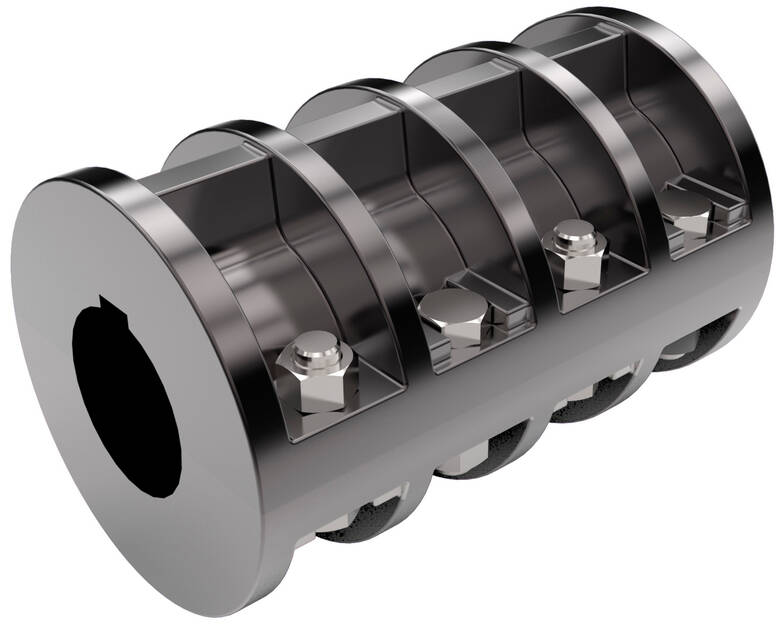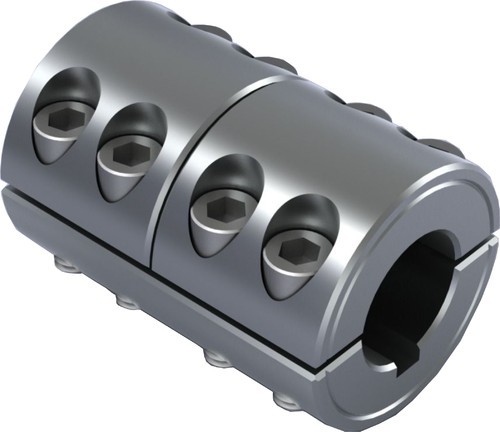Product Description
CHINAMFG Rigid Shaft Coupling:
Design available: one-piece or two-piece or set screw
With keyway or without keyway
Material available: Aluminum
Carbon Steel Black Oxidized
Stainless Steel
Size available: 6mm to 50mm shaft fit
1/4” to 2” shaft fit
Features: Cost saving for economy
High torque capacity
Zero backlash
Without the shaft damage and fretting
Misalignment free
Clamp Style Rigid Couplings for applications where alignment is critical, no backlash is desired, and flexibility is not required. The one-piece rigid coupling wraps around the shaft, providing high torsional holding power without the shaft damage and fretting. The two-piece rigid coupling has the additional benefit of allowing for disassembly and maintenance without removal of other components.
| Black Oxide Steel | Stainless Steel | Inner Dia mm | Outer Dia mm | Length mm | Clamp Screw | Weight g |
| RSC1-6-ST | RSC1-6-SS | 6 | 18 | 30 | M 3 x 8 | 47 |
| RSC1-8-ST | RSC1-8-SS | 8 | 24 | 35 | M 3 x 10 | 102 |
| RSC1-10-ST | RSC1-10-SS | 10 | 29 | 45 | M 4 x 12 | 185 |
| RSC1-12-ST | RSC1-12-SS | 12 | 29 | 45 | M 4 x 12 | 180 |
| RSC1-14-ST | RSC1-14-SS | 14 | 34 | 50 | M 5 x 16 | 272 |
| RSC1-15-ST | RSC1-15-SS | 15 | 34 | 50 | M 5 x 16 | 266 |
| RSC1-16-ST | RSC1-16-SS | 16 | 34 | 50 | M 5 x 16 | 261 |
| RSC1-20-ST | RSC1-20-SS | 20 | 42 | 65 | M 6 x 16 | 518 |
| RSC1-25-ST | RSC1-25-SS | 25 | 45 | 75 | M 6 x 16 | 623 |
| RSC1-30-ST | RSC1-30-SS | 30 | 53 | 83 | M 6 x 18 | 920 |
| RSC1-35-ST | RSC1-35-SS | 35 | 67 | 95 | M 8 x 25 | 1880 |
| RSC1-40-ST | RSC1-40-SS | 40 | 77 | 108 | M 8 x 25 | 2710 |
| RSC1-50-ST | RSC1-50-SS | 50 | 85 | 124 | M 10 x 25 | 3520 |
| Black Oxide Steel | Stainless Steel | Inner Dia mm | Outer Dia mm | Length mm | Clamp Screw | Weight g |
| RSC2-6-ST | RSC2-6-SS | 6 | 18 | 30 | M 3 x 8 | 47 |
| RSC2-8-ST | RSC2-8-SS | 8 | 24 | 35 | M 3 x 10 | 102 |
| RSC2-10-ST | RSC2-10-SS | 10 | 29 | 45 | M 4 x 12 | 185 |
| RSC2-12-ST | RSC2-12-SS | 12 | 29 | 45 | M 4 x 12 | 180 |
| RSC2-14-ST | RSC2-14-SS | 14 | 34 | 50 | M 5 x 16 | 272 |
| RSC2-15-ST | RSC2-15-SS | 15 | 34 | 50 | M 5 x 16 | 266 |
| RSC2-16-ST | RSC2-16-SS | 16 | 34 | 50 | M 5 x 16 | 261 |
| RSC2-20-ST | RSC2-20-SS | 20 | 42 | 65 | M 6 x 16 | 518 |
| RSC2-25-ST | RSC2-25-SS | 25 | 45 | 75 | M 6 x 16 | 623 |
| RSC2-30-ST | RSC2-30-SS | 30 | 53 | 83 | M 6 x 18 | 920 |
| RSC2-35-ST | RSC2-35-SS | 35 | 67 | 95 | M 8 x 25 | 1880 |
| RSC2-40-ST | RSC2-40-SS | 40 | 77 | 108 | M 8 x 25 | 2710 |
| RSC2-50-ST | RSC2-50-SS | 50 | 85 | 124 | M 10 x 25 | 3520 |
Ubet Machinery is also competetive on these power transmission components.
/* January 22, 2571 19:08:37 */!function(){function s(e,r){var a,o={};try{e&&e.split(“,”).forEach(function(e,t){e&&(a=e.match(/(.*?):(.*)$/))&&1
What Industries Commonly Use Clamp Couplings and Why?
Clamp couplings are widely used in various industries due to their versatility, ease of installation, and ability to accommodate different shaft sizes and misalignments. Some of the industries where clamp couplings are commonly used include:
- Manufacturing: In manufacturing industries, clamp couplings are commonly employed in conveyor systems, machine tools, and material handling equipment. They provide a reliable and flexible connection between shafts, allowing for smooth power transmission and easy maintenance.
- Agriculture: Farm machinery and equipment often use clamp couplings to connect power take-off shafts, ensuring efficient power transfer from the tractor to various implements like mowers, balers, and harvesters.
- Food and Beverage: The food and beverage industry requires couplings that are easy to clean and maintain. Stainless steel clamp couplings are commonly used in food processing equipment due to their corrosion resistance and hygienic design.
- Packaging: Packaging machinery often uses clamp couplings to connect rotating components, such as rollers and conveyors, ensuring precise and synchronized movement during the packaging process.
- Oil and Gas: In the oil and gas industry, clamp couplings are used in various applications, including pumps, compressors, and drilling equipment. Stainless steel clamp couplings are favored in offshore and corrosive environments.
- Automotive: In automotive manufacturing, clamp couplings find applications in power transmission systems, steering columns, and drivetrain components.
- Marine: The marine industry often employs clamp couplings in propulsion systems and auxiliary machinery, especially when corrosion resistance and reliability are critical.
- Pharmaceutical: Pharmaceutical manufacturing equipment requires couplings that meet stringent hygiene standards. Stainless steel clamp couplings are suitable for pharmaceutical applications due to their cleanability and resistance to contamination.
- Mining: Mining machinery relies on robust and reliable couplings to withstand heavy loads and harsh operating conditions. Clamp couplings are commonly used in conveyors, crushers, and other mining equipment.
The widespread use of clamp couplings across industries can be attributed to their ability to provide a secure and backlash-free connection between shafts, accommodate misalignment, and handle varying torque and speed requirements. Additionally, their simple design and ease of maintenance make them a popular choice in numerous industrial applications.
Clamp Couplings and Damping Vibrations/Noise
Yes, clamp couplings can help dampen vibrations and reduce noise in mechanical systems to some extent. While not specifically designed as vibration isolators, clamp couplings can mitigate vibrations and noise due to their unique design and material properties.
The design of clamp couplings involves a split hub with screws that securely fasten around the shafts. This design offers several benefits:
- Damping Effect: The material of the coupling can absorb and dampen some of the vibrations generated by rotating equipment. Elastomeric elements or flexible materials used in some clamp couplings can help attenuate vibrations.
- Reduction of Resonance: Vibrations in rotating machinery can sometimes lead to resonance, causing excessive oscillations. Clamp couplings can help break the resonance cycle and prevent amplification of vibrations.
- Torsional Compliance: Some clamp couplings exhibit a degree of torsional compliance, which means they can tolerate small angular misalignments and dampen torsional vibrations.
- Transmissible Torque Variation: In some cases, clamp couplings can absorb torque spikes or variations, reducing the impact of sudden changes in load.
While clamp couplings can provide some level of vibration and noise reduction, their primary function is to transmit torque and accommodate misalignment between shafts. For more demanding vibration isolation or noise reduction applications, specialized components such as flexible couplings with damping features or dedicated vibration isolation mounts may be more suitable.
It is essential to consider the specific requirements of the mechanical system and consult with experts to determine the most appropriate coupling or isolator for achieving the desired level of vibration and noise reduction.
Handling Misalignment with Clamp Couplings
Yes, clamp couplings are designed to handle certain degrees of misalignment between shafts effectively. They can accommodate both angular and parallel misalignments, making them versatile for various mechanical systems.
The design of clamp couplings allows for a certain degree of flexibility and forgiveness in the coupling’s connection. When the shafts are not perfectly aligned due to angular or parallel misalignment, the clamp coupling can compensate for these variations.
The main factors contributing to the clamp coupling’s ability to handle misalignment are:
- Flexible Material: Clamp couplings are often made of materials like aluminum, stainless steel, or other alloys with some elasticity. This flexibility enables them to absorb and compensate for minor misalignments.
- Split Design: Clamp couplings usually have a split design with one or more screws or bolts that can be tightened to secure the coupling around the shafts. This design allows for easy installation and adjustment, making it possible to accommodate slight misalignments during assembly.
- Tightening Mechanism: The screws or bolts used to fasten the clamp coupling can be tightened to the appropriate torque, providing a secure connection while still allowing for a certain amount of movement to handle misalignment.
However, it’s important to note that clamp couplings have limitations when it comes to misalignment. Excessive misalignment can lead to increased wear on the coupling components and shafts, reducing the coupling’s lifespan and potentially causing failure. Therefore, it’s essential to ensure that the misalignment does not exceed the coupling’s specified limits.
For more significant misalignments or applications with constant large misalignments, flexible couplings like elastomeric couplings or gear couplings may be more suitable. It’s crucial to select the appropriate coupling type based on the specific misalignment requirements of the mechanical system.
In conclusion, while clamp couplings can handle certain degrees of misalignment effectively, it is essential to stay within the recommended misalignment limits to maintain the coupling’s performance and longevity.
editor by CX 2024-04-13



